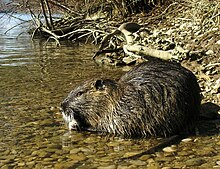Coypu
| Coypu Temporal range: Late Pliocene–Recent |
|
|---|---|
 |
|
| Scientific classification | |
| Kingdom: | Animalia |
| Phylum: | Chordata |
| Class: | Mammalia |
| Order: | Rodentia |
| Family: |
Myocastoridae Ameghino, 1904 |
| Genus: |
Myocastor Kerr, 1792 |
| Species: | M. coypus |
| Binomial name | |
|
Myocastor coypus (Molina, 1782) |
|
The coypu (from Spanish coipú, from Mapudungun kóypu;Myocastor coypus), also known as the river rat or nutria, is a large, omnivorous, semiaquatic rodent and the only member of the family Myocastoridae. Originally native to subtropical and temperate South America, it has since been introduced to North America, Europe, Asia, and Africa, primarily by fur ranchers. Although it is still valued for its fur in some regions, its destructive feeding and burrowing behaviors make this invasive species a pest throughout most of its range.
Coypus live in burrows alongside stretches of water. They feed on river plant stems.
Two names are commonly used in English for Myocastor coypus. The name "nutria" is generally used in North America, Asia, and throughout countries of the former Soviet Union; however, in Spanish-speaking countries, the word "nutria" refers to the otter. To avoid this ambiguity, the name "coypu" (derived from the Mapudungun language) is used in Latin America and Europe. In France, the coypu is known as a ragondin. In Dutch, it is known as beverrat (beaver rat). In German, it is known as Nutria, Biberratte (beaver rat) or Sumpfbiber (swamp beaver). In Italy, instead, the popular name is, as in North America and Asia, "nutria", but it is also called castorino ("little beaver"), by which its fur is known in Italy. In Swedish, the animal is known as sumpbäver (marsh-/swamp beaver). In Brazil, the animal is known as ratão-do-banhado, nútria, or caxingui (the last from the Tupi language).
The coypu was first described by Juan Ignacio Molina in 1782 as Mus coypus, a member of the mouse genus. The genus Myocastor, assigned in 1792 by Robert Kerr, is derived from the Greek mys and kastor, or "mouse-beaver".Geoffroy, independently of Kerr, named the species Myopotamus coypus, and it is occasionally referred to by this name.
...
Wikipedia

